#Not often that happens but superhero comics seem to have a knack for it
Text
Casually looking through caps wiki to get a list of powers, skills, important canon events, and

HE'S THE SAME AGE AS NIGHTWING?!
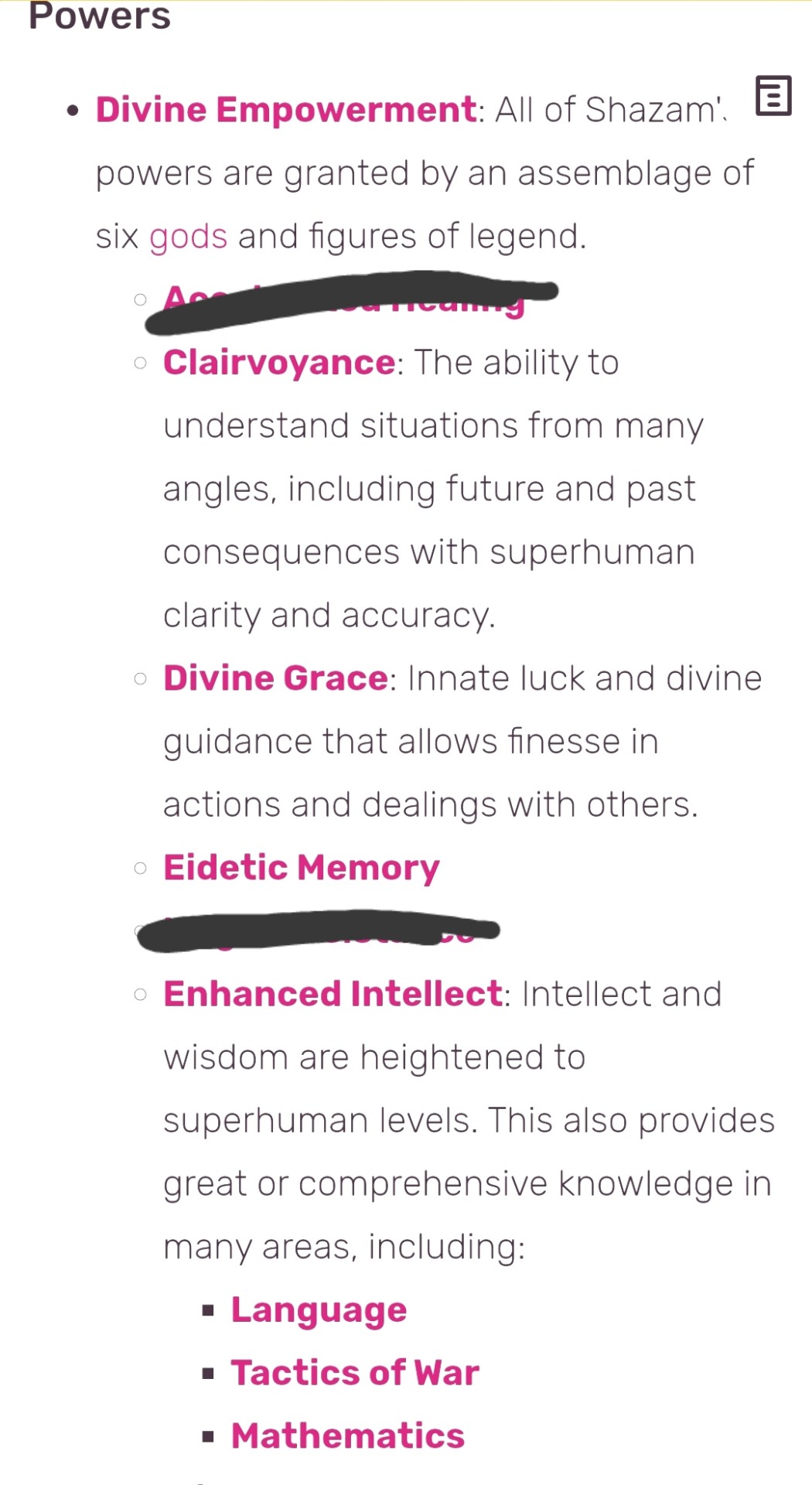
THIS KID HAS EDICTIC MEMORY?!! ANCIENT SUMERIAN WAR TACTICS ON SPEED DIAL??! Billy can do maths like it's an extreme sport???
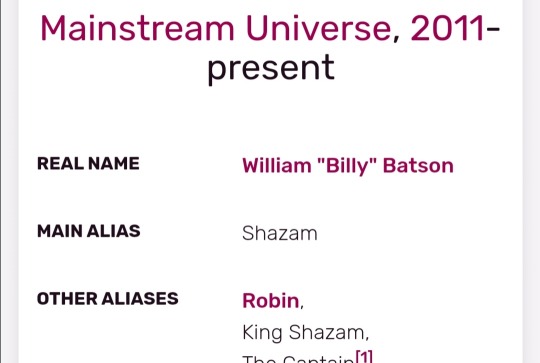
W H A T.
for context:
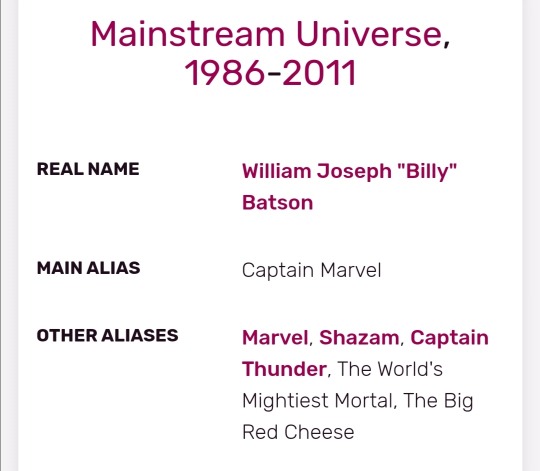
Pre reboot this is nowhere to be seen, he's just normal and Vibing. King??!!!! ROBIN?!!!
#Another instance of canon being crazier than fanon#Not often that happens but superhero comics seem to have a knack for it#holey moley#WHEN WAS BILLY A ROBIN??!!#I've seen some posts floating around about Billy winning a bet and getting Tim's suit while Tim is benched well HEY#Also someone mentioned a nightwing and cap age similarity headcanon and now! You know!#captain marvel#dc captain marvel#captain marvel dc#shazam#billy batson#justice league#batman#batfam#dc comics#nightwing#dick grayson#robin#dc robin#robin dc#bat family#Anyway for the fan creators this is excellent news I see a lot of people writing really cool stuff we can add to#Cap casually referencing his time as Robin and all conversations screech to a halt
405 notes
·
View notes
Text
Fall 2020 Anime Overview
I started out watching the a ton of anime for the Fall 2020 season, but then ended up not being caught up with most of them by the the time the end rolled around. I still pretty much intend to catch up with Yashahime Princess Half Demon someday (I do like the three leads, it just the plot’s been dull as dirt and the fights aren’t very inspired either) and though I dropped Wandering Witch after bad press started rolling in (I CANNOT deal with pointless tragedy in my current state of mind) I might check out a few more episodes someday just to from my own opinion. For now, let’s just quickly review the anime I DID manage to finish on time this season.
Sleepy Princess in the Demon Castle
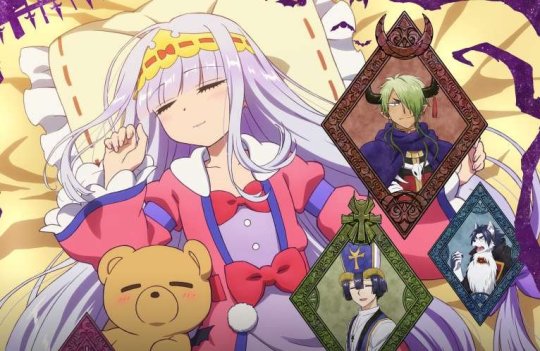
Sleepy Princess in the Demon Castle is exactly what it says on the tin: Princess Syalis isn’t too bothered about being captured by demons and locked in their castle, but she does value a good night’s sleep, and she is absolutely ruthless when it comes to getting it- so ruthless, in fact, that the demons realized it might not be that she’s trapped in here with them, but that they’re trapped in here with her.
Sleepy Princess is top tier comedy comfort food. It rarely got a huge belly laugh, but it always but a smile on my face and was a great thing to watch before going to bed. Syalis’s single-minded search for some shut eye is a joke that could have gotten old very quickly, but the show consistently found creative ways to expand on the gags and build it’s world and a fun cast of characters along the way.
Though Syalis is downright brutal to the demons when it comes to getting what she wants (and has a knack for getting herself killed at well), thanks to a demon cleric that offers easy resurrections, you never feel too bad for anyone involved. In fact, the demons and Syalis form a strangely heartwarming bond over the course of the show , and it’s clear by the end that Syalis definitely has the ability to come and go if she damn well pleases and just finds this castle a fun place where she can find respite from her princessly responsibilities.
A nice bonus for those of us who like a little subversion is that the show has a lot of fun playing with standard adventure tropes- the demons often lament that Syalis is not at all what they expected from a captive princess, for one, but my favorite fun little twist is how Syalis feels about the hero currently on a (seemingly endless) quest to rescue her- she manages to both hold him in contempt AND consistently fail to remember his name. That level of disregard takes some impressive effort.
The show has the same director as the Gekkan Shoujo Nozaki-kun anime and as such has a similarly nice comic and visual flourishes throughout. It definitely gets two sleepy thumbs up for me.
Jujutsu Kaisen
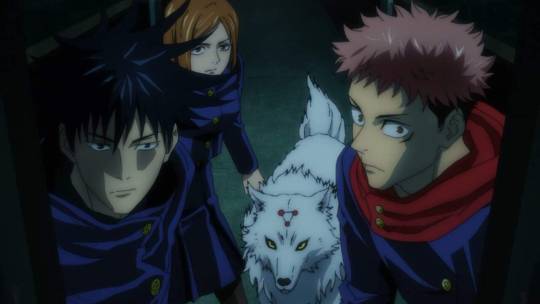
Jujutsu Kaisen follows a young man named Yuuji Itadori who, after tangling with a demon, ends up with one inside him. With a death sentence hanging over his head, he’s inducted into a school for “jujutsu sorcerers”, and begins training to use his newfound powers to defeat demons and curses.
Jujutsu Kaisen quickly tells you on no uncertain terms it is Action Shonen, introducing a huge cast of a characters and powers and super high stakes and hey there’s even gonna be a tournament arc soon. It is really, really pretty to look at, with a killer opening and ending, some seriously great animation and cool visuals for the fights especially. But is it particularly memorable otherwise? Noooooot really, so far. The sea of technobabble it tends to descend into when trying to explain how the various powers work often has me zoning out and wishing they’d just let me watch the pretty punches. The villains and the general plot isn’t particularly compelling. The characters are nice enough, but haven’t given me much to be attached to so far. Though I do appreciate this one dude who is the embodiment of millennial ennui:
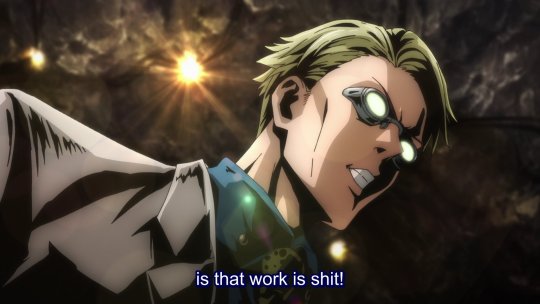
I’ll keep watching though, because it is a visually stunning, action-y thing to my turn your brain off to and god knows I want to turn my brain off all the time lately.
And the characters do have potential- the One Girl of the main group, Nobara, has a really fun personality in that she’s a total shitlord doofus brawler who can thus doof around with our equally dumbass protagonist, which is an pretty fun, unusual personality for the One Girl to have! Her interactions with Maki, the weapons expert senpai girl, are promising too. I’m just waiting for her to actually, you know, DO something that really shows off her skills- I’m told she DOES eventually get to (gasp) win fights on her own and do cool stuff, but so far show has kind at that of failed miserably and underused her like most action shonen underuse their girls. Plus, taking Yuuji out of the group for such a long stretch seems like a weird choice, we’ve been deprived really seeing him for relationships with his peers. The pacing seems off. But maybe the upcoming tournament arc will make up for that and actually be worthwhile!
Talentless Nana
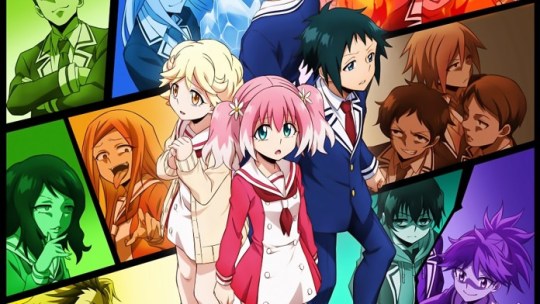
In a world where kids with superpowers are sent to island schools to fight mysterious “enemies of humanity”, one class of such kids is thrown into chaos when they find themselves targeted by a deadly force.
It’s pretty much impossible to talk about Talentless Nana without discussing how it deviates dramatically from what its premise appears to be in episode one, so I’ll just say if you like stories with superpowers and intrigue, you should definitely sit through that first episode and see if the plot that’s eventually revealed is something that you’re here for. But if you want to avoid spoilers, DON’T GO BELOW THE CUT, because I’m about to get very spoilery.
Basically, Talentless Nana pulls a bait and switch, starting it’s first episode posing as generic superhero anime where the protagonist appears to be your standard meek-but-powerful anime boy (Nanao) who just needs some support and encouragement from a pink haired mind reading manic pixie dream girl (Nana) to unlock his self-confidence and ~true power~ (ugh)...only to take SHARP swerve when Nana ruthlessly murders Nanao and reveals she’s been sent by the government to take out the superpowered kids one by one because THEY are the considered the true enemies of humanity. Oh, and she doesn’t have any superpowers, or “talents”- she was just able to sus out everything Nanao was thinking through basic deductive reasoning because he was so flippin’ obvious and basic.
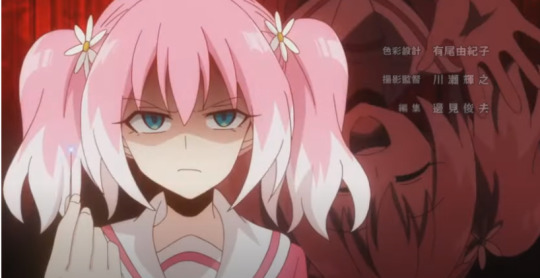
As my love for a certain character in a certain game may have clued people into, I am ALWAYS delighted when what appears to be a generic, underwritten girlfriend character is then revealed to be an interesting, ruthless mastermind. And having an anime appear to be about a bland boy with a Dream Girlfriend but then actually turn into a show about a deeply cynical, morally dubious girl who’s clearly holding down a lot of messy feelings as she considers everyone her enemy...well, it may be a cheap trick to some, but it also feels a little bit like justice for all the underwritten female characters sacrificed to bland male leads. It’s still rare enough that I dig it when it happens. And the metatext of Nana zeroing in on this kid as the most standard of main character boys, assessing him as the biggest threat because of it and knowing the perfect way to take him out, is pretty inherently funny to me.
But if the show JUST banked on that twist and was about Nana brutally and cynically slaughtering these kids, it would get boring quickly and Nana would be a bland character herself. Fortunately, it doesn’t go that route. Nana struggles and grows a lot over the course of the show. She finds opposition in transfer student Kyoya, a stoic (and socially awkward) young man who pretty quickly becomes suspicious of her. A lot of the tension from the early episodes comes from her sweating as she tries to outmaneuver him and she makes plenty of mistakes along the way. She also slowly but surely starts to question her mission, and we get an idea of her backstory and how the government specifically has groomed her into believing people with powers to be evil. That belief is one that’s challenged by her friendship with another girl, and it’s pretty rewarding to watch Nana’s feelings and world expand little by little.
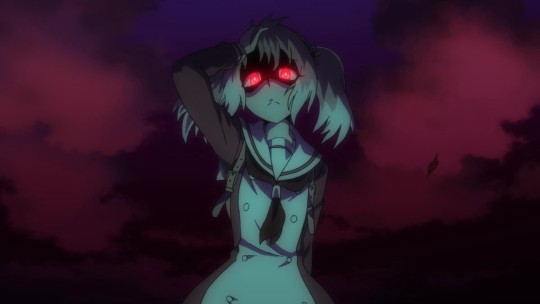
The show is definitely a little schlocky-some of the plots (as well as the general premise of the government thinking this is the optimal way to get rid of their superpowered kids problem) fall apart if you think too much about them, and some of the kids Nana goes up against are sleazy and unlikeable in over the top ways (which makes it easy for her to stick to her convictions all these kids deserve to die at first). In particular, I have to give a heads up for some sleazy guys doing and saying sleazy things, though the show never gets too overbearing or graphic with it (and the gore is generally PG-13 level as well).
Basically. There are some truly ridiculous happenings in this show. But how ridiculous and pulpy and over the top it is can be part of the appeal, and it’s fun to just sit back and watch the spectacle of Nana and her peers head-scratching machinations.

So, while certainly not an anime with airtight construction or flawless quality and depth, I found Nana an overall entertaining watch, especially as a fan of cat-and-mouse murder-y shenanigans, and thought it has a very compelling main character and managed to end on a heartwrenching (but earned) note. I definitely wouldn’t say no to a second season and would be interested to see where things go from here.
#anime overview#sleepy princess in the demon castle#jujutsu kaisen#talentless nana#munou na nana#maoujo de oyasumi#fall 2020 anime#anime#my reviews
93 notes
·
View notes
Photo
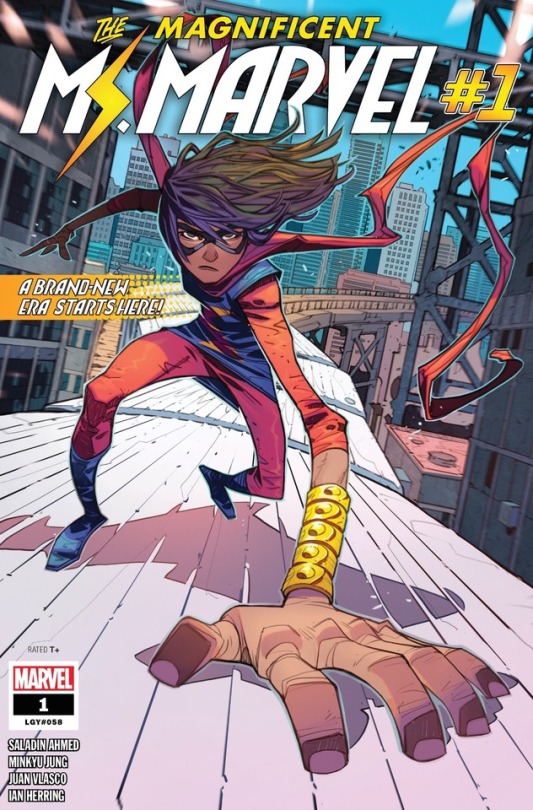
The Magnificent Ms. Marvel #1 Review
spoilers spoilers spoilers spoilers spoilers spoilers spoilers spoilers spoilers
A new chapter in the adventures of Kamala Khan begins here as the reigns are handed over to the new creative team of writer, Saladin Ahmed, artists Minkyu Jung and Juan Vlasco and colorist Ian Herring. And it’s clear from the start that this new era of Ms. Marvel comics is going to see things getting more grim and harrowing for our hero. Quick recap and review following the jump.
The tale begins on a far off alien world where a father is trying to get his young daughter to go to sleep. He agrees to tell her one last bedtime story about the ‘Destined One’ a hero from another world who quite clearly is Ms. Marvel.
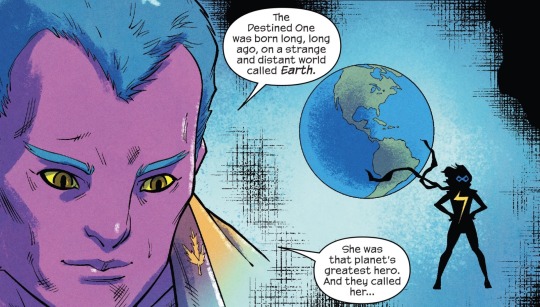
Elsewhere, back on earth, Ms. Marvel battles some grade Z super villain calling himself Deathbringer. Ms. M is able to make short work of the villain, but not without some collateral property damage which causes her to get yelled at by a store owner. The tale of a celebrated and honored hero that the alien dad tells his daughter seems a far cry from reality for Ms. M.

After helping to clean up, Kamala rushes to a hip new restaurant to meet Nakia. The two don't share any classes together this semester and seems like it has been forever since they caught up. Kamala had recently divulged to her friend her secret identity as Ms. Marvel and Nakia wants to know how it was that she gained her super powers. The recap Kamala provides offers a quick review for new readers and those unfamiliar with Kamala’s origin. She tells Nakia about being exposed to the Terrigen Cloud and how it unlocked her Inhuman powers; as well as her decision to use these new abilities to become a hero, following the path of her one time idol, Carol ‘Captain Marvel’ Danvers.
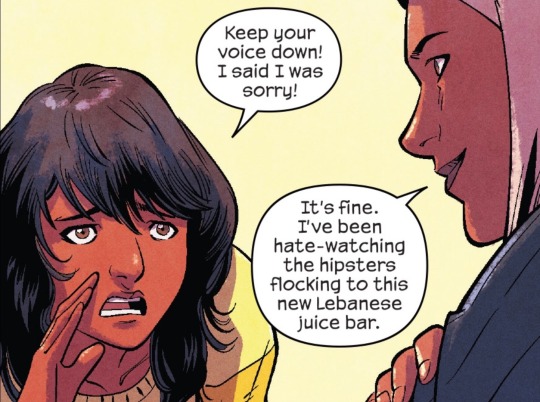
Kamala returns to her home to find her parents waiting for her. They’re not looking too happy. Kamala had told her mom about her exploits as a super hero during the Last Days arc when they both thought the world was coming to an end. And now it appears as though her mom has finally shared that secret with her dad. And while Mrs. Khan was able to understand and accept Kamala’s need to use her abilities to help others, Mr. Khan feels differently. It’s just too dangerous; he cannot abide by it, cannot allow the risk to his daughter’s safety.

There’s an undertone to the argument between Kamala and her father that remains unsaid. He talks about a time when Kamala was a baby and got very sick; how helpless and frightened it made him feel. It seems as though there is something Kamala’s dad needs to tell her but cannot find the words to say. It sort of feels like Mr. Khan may have recently found out that he is sick, that he may have been diagnoses with a life-threatening disease… but the specifics are left unsaid as Kamala storms out, frustrated that her dad so refuses to understand her need to serve the greater good.
Her dad follows but there’s no time to continue their conversation. She’s received a distress call from Bruno informing her that the Circle Q is under attack by a monster. Kamala dashes off before her dad can object.
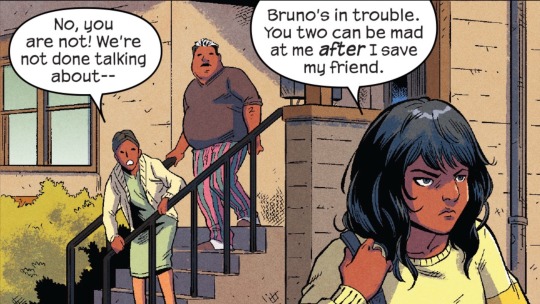
There is indeed a monster rampaging the Circle Q. Ms. Marvel engages it, exchanges a few blows and that uses her stretching powers to slam it against a wall. At which point the monster disintegrates into purple ooze. Before Ms. M and Bruno have time to try to figure the matter out, they learn that yet another monster is attacking the harbor. Ms. M springs back into action and battles this second monster. And once more the creature is rendered into a purple slime after it is defeated. It’s all quite mysterious.
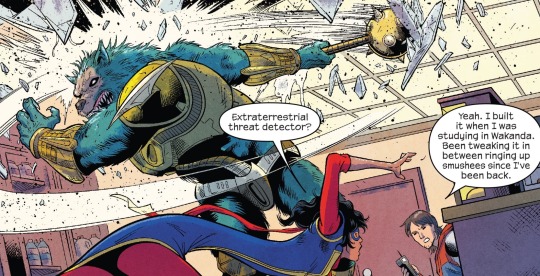
Bruno has been using a device he developed using Wakandian technology to track the appearances of these strange monsters and much to their dismay he alerts Ms. M that the latest monster has manifested in her home.

Kamala rushes home, terrified that something awful could happen to her mom and dad. She is relived to make it home and find that there appears to be no monsters present, that her parents seem to be just fine… …or are they? They seem distant and cold. Kamala tries to hug them, yet just as she does so they both disintegrate into purple ooze.
And it is on this harrowing cliffhanger that the issue comes to a close with the promise of continuation in the next installment.

Ahmed and company take on a very tall order in relaunching Ms. Marvel following the popularity and acclaim of the original series. I don’t envy the pressure Mr. Ahmed must feel in taking things over from G. Willow Wilson. Yet this is a very promising start and a whole lot is jammed into the issue and the script makes it abundantly clear that Mr. Ahmed is intent on continuing the trend of equally balancing Kamala’s family and social life alongside the standard superhero action.
Mr. Ahmed has often excelled at writing dialogue and giving his characters a distinctive voice. And this knack is quite evident in the issue. Kamala, her parents and the extended cast seem true to themselves. Yet Amed is not so much parroting Willson’s dialogue style as much as honoring it and building forward off of it. Kamala is still her goofy self, over-taxed by her self-assigned obligations, but there is a bit of a harder edge to it. She’s more firm in sticking up for herself, but perhaps still struggling with how to do so without coming across as surly. And this is by no means uncommon among teenagers on the cusp of young adulthood.
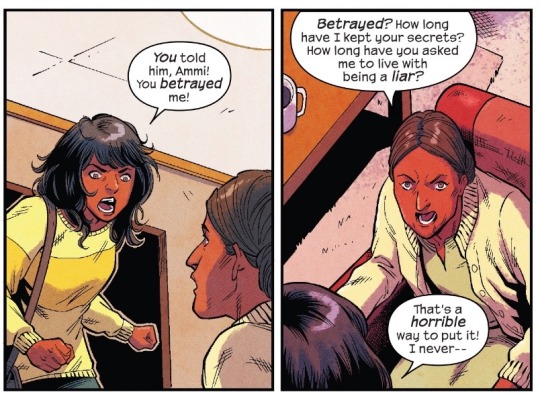
And just as Kamala’s voice has a slightly more mature tone, so to does the general tenner of the plot. It remains unclear where this monsters have come from, what has happened to Kamala’s parents and what it all has to do with Ms. M being the ‘promised one’ and the figure of bedtime stories on an alien world. Whatever the case, the stakes appear to be much more dire than they have been for Ms. M in the past.

Minkyu Jung’s penciling and Juan Vlasco’s inks are a good match for Ahmed’s script. The style is slightly more grown up compared to the previous work of Nico Leon, Takeshi Miyazawa and Adrian Alphona. Jung does some really neat work in showing off Ms. Marvel’s powers and the line work is fluid and confident throughout.

Ian Herring’s colors are, as always, terrific. He has colored all of the previous Ms. marvel comics and his coloring offers a very much welcome sense of continuity bridging this new series from its predecessor.
The book doesn’t have the same sense of whimsey as Wilson and company’s run. There are no silly bits like raccoons in the corner eating an ice-cream cone. Yet I don’t blame Ahmed and company for not trying to recapture that same feel. It would have felt too much like copying and I’m all for the new team bringing their own feel to the book.
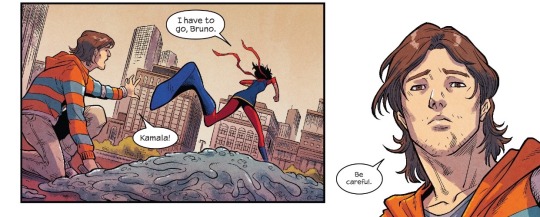
I’m still missing the way things used to be, but this is a promising start to a new beginning and the next chapter in Kamala’s adventures. Definitely recommended!
Four and a half out of five Lockjaws.

#Ms. Marvel#Kamala Khan#The Magnificent Ms. Marvel#Saladin Ahmed#Minkyu Jung#Juan Vlasco#Ian Herring#review#spoilers#Inhumans
46 notes
·
View notes
Text
Starman (1988-1992)
There are at least six or seven DC superheroes called “Starman.” I know that mainly because the most interesting thing DC can come up with to do with these characters is have them stand around and talk about how many of them there are. It’s a decent name that’s gone back and forth between homages to the original 1941 character and totally new ideas that never completely stuck. The pinnacle of this odd, patchwork legacy is James Robinson’s Starman (1994-2001), featuring Jack Knight. This, however, is the Roger Stern/Tom Lyle version, starring Will Payton.

(He has two faces, and somehow they both always look like he just realized he sharted.)
It’s funny how, until just now, I never thought about how Will Payton’s series ended just two years before Jack Knight’s started. Will is “killed” in the 1992 Eclipso crossover, and Jack is introduced amid 1994′s Zero Hour. The space between those events feels enormous in my mind, probably because I was just getting into comics back during that period.
The Stern/Lyle Starman stands out because I can’t think of many Copper Age DC heroes who debut in their own solo series with so few ties to existing lore. He’s not spinning out of a run in a team book, or the supporting cast of a more prominent hero’s series. He’s not taking up the legacy of an established brand name--aside from the fact he has virtually nothing to do with any other Starmen, there wasn’t exactly a big market hankering for that kind of thing anyway. For all intents and purposes, the series starts cold with “guy who’s never even met a superhuman gets superpowers, let’s see what he does with them.” It’s interesting how Roger Stern approaches that premise.
Starman #1 begins by establishing that Bad Guy Institute is using a satellite to fire a plot-device ray at the Earth’s surface, to give some bad guys super powers. We’re shown that the beam missed its intended target, and we’re shown that Will Payton is found unconscious in a scorched clearing a month later. Right away I’m dubious, because Stern has a knack for using the medium of comics to misdirect you into juxtaposing coincidences into correlations. He writes 28 of the 45 issues of Starman, and in all that time I don’t think he ever confirms the Bad Guy beam is the phenomenon responsible for Will waking up with superpowers. Many characters surmise that’s what happened, but there’s always an opening for someone to realize no one actually checked, that Payton was hit with something else and someone else has been running around all this time with the Bad Guy beam powers.
(The closest we get to an “everything you know is wrong” moment is late in the series when Eclipso claims he knocked the beam off-target to arrange Starman’s creation. Why he would care who gets the powers isn’t explained. There’s also a retcon in the Robinson Starman series so that the beam somehow infused/replaced Payton with the essence of Prince Gavyn, the 1980 version of Starman.)
Once Payton has powers, he has to decide what to do with them, and this is where Stern’s grasp of fundamentals of the genre shines. It isn’t a given that the logical thing to do with superpowers is to play Superman or join the Justice League, even in a world where Superman and the Justice League actually exist. Will considers first responders to be the real heroes; his powers don’t give him the right to presume he can do their job. That reasoning would free him to focus on resuming his ordinary life without the powers getting in his way, except he can’t help but hear about trouble and offer to help...if he can. (He can always help, but he always asks anyway.)
The biggest driver for drama in Starman is Will’s preoccupation with keeping his superhero career from interfering with his “normal” life. He is constantly looking for jobs or deciding whether to move out of his mother’s house or balancing his responsibilities with guarding his secret identity. This is familiar to anyone who’s read Spider-Man, except that Starman solves more of these problems than Payton cares to admit. He doesn’t actually need to eat, drink, sleep, breathe, or even go to the bathroom, so if you stop and think about it his job/money problems are kind of academic. Having a place to live seems important until you consider Will already loved to go hiking for weeks at a time. Technically he could just spend his non-Starman time as a drifter and he’d come out ahead. This train of thought gets more interesting when we learn Will’s father was literally a drifter.
Will Payton is a very bland character--straight as an arrow, humble to a fault, and absurdly noble. The closest thing he has to a character flaw is his insecurity about doing a good enough job as a superhero. He constantly worries that he could have done more, and berates himself for things that aren’t his fault. This comes into focus in issues #16-25, as he sorts out his feelings about his father abandoning the family when he was a kid. Now, Stern’s writing tends to bluntly state characterization in inner monologue, but around this point the most interesting stuff about Will is left for us to read between the lines: He’s hyper-responsible to compensate for his father’s irresponsibility. He’s terrified of being a disappointment, and he knows painfully well that “sorry” often isn’t good enough. With Starman’s powers, Will could be quite content living his father’s lifestyle, except the thought of being anything like his father disgusts him.
Unfortunately, just as this starts getting interesting, Stern wraps up his run as writer. Len Strazewski takes over and it’s...not as good. To his credit, he has Will finally follow through on one of the many potential love interests Stern set up, although he then has Kitty Faulkner constantly wondering how she can measure up with the likes of Phantom Lady and Power Girl, which is kinda eeeuggh. (Male comic creators depicting women reacting to superheroine sex symbols always feels kinda gross to me.) In one issue an old villain possesses an Elvis impersonator and it sucks a lot. In another Phantom Lady suggests that she and Kitty should deal with their problems in the time-honored tradition of SHOPPING! It’s actually interesting to me how consistent this shittiness is with other contemporaneous shitty comics, but that’s another post I think.
I would be remiss if I did not call out Starman #35--a fill-in written by Keith Giffen and Peter David--as one of the worst comic books I have ever read. I am still kinda angry that I read it.
In closing, Starman #1-28 is a very workmanlike model for how a Copper Age superhero operates, without the baggage of tying into a million different things. It may be worthy of study on those grounds alone, although if you really want to see Roger Stern kick some ass, I’d stick with his runs on Action Comics or Avengers.
4 notes
·
View notes
Text
Kevin Smith, The Continuation of Style, and What it Means to be an Auteur
In 1994, Clerks debuted at Sundance, jumpstarting the career of young filmmaker Kevin Smith. Made on a shoestring budget, this grainy, raunchy, quirky comedy made its way into the spotlight, and quickly became a household name, thrusting Smith into the Hollywood scene. In the years since his debut, Smith has made many films, on both independent and Hollywood budgets. Die-hard fans of Smith have stuck with him over the decades, even when his big-budget films are critically panned at the box office, such as his 2010 effort Cop Out. However, despite the critical acclaim or disdain Kevin Smith may receive, he has a distinctive style when creating his films. This paper sets out to explore how Kevin Smith crafts his films, on both low and high budgets. This includes how he writes his stories and characters, along with how he shoots his films, while finally answering the question ‘Can Kevin Smith be considered an auteur?’.
Clerks debuted in the midst of the independent film boom of the 1990s. The film’s grainy, black-and-white style, matched with minimalist shots fit in perfectly with the do-it-yourself feeling that was present during this time. Clerks is not a complexly-shot film; most of its scenes are shot/counter-shot conversations between two characters, or one camera pointing at characters during dialogue. Smith has even said this himself; when asked if he is a stronger writer or director, he had this to say: “A writer. I just don’t think I have a directorial instinct. I think it all comes from writing and that’s why the films don’t have a fantastic visual style to them. In fact, there’s no visual style to them. There’s a lot of banter and a lot of talk.” (Smith).
However, for many people, this is what made Clerks so interesting and cool. It didn’t pretend to be anything more than it was, which is representative of Smith, too, in a way. While researching Kevin Smith, I found that ever since he was a kid, he has been infatuated with comic books, and writing and drawing them. In fact, Smith writes his films similarly to the way one would write a comic book series. Many of his movies take place in what he refers to as “The Askewniverse”. This “universe” contains the characters, cities, and events that happen in most of Smith’s films, just like how a comic book universe, like the Marvel Universe, would contain all of its superheroes and worlds. This approach to writing films feels very organic and personal, with Robert Ebert describing it as a “...great invention, a natural feel for human comedy, and a knack for writing weird, sometimes brilliant, dialogue.” (Ebert) in his review when the film was initially released. When watching Clerks, and listening to the dialogue written by Smith, the viewer gets a sense that he is writing about experiences that he is very familiar with. This gives the dialogue a genuine feel to it, since Smith seems to know what he’s writing about, like he has actually experienced these situations he is putting on the screen. However, it can also feel amateur and immature after some time. This way of writing is fine for Clerks, since it was Smith’s debut, and therefore it couldn’t be compared to any other works of his, but as one continues through his catalogue of films, a pattern quickly emerges when looking at Kevin Smith’s dialogue choices. Clerks, Clerks II, and Mallrats all share a common theme of raunchy, immature, and frankly gross dialogue that is entertaining in Smith’s debut, but quickly grows tiresome when that is all the viewer is exposed to. The writing in Clerks, albeit focused on gross topics, is still smartly written, and comes off as witty, without trying too hard. However, if one was to watch a clip from Clerks II, they would recognize Smith’s characters, because frankly, they don’t grow at all between the two films, and neither does their writing. Clerks II takes places ten years after Clerks, and yet the writing did not age at all.The raunchy humor loses its wittiness, and instead feels forced in Smith’s later films. Most of his big-budget films do not take place in his “universe”, and yet the writing feels like it could. In Cop Out, for example, Smith relies heavily on jokes involving raunchy descriptions of sexual innuendos, and continues with the vivid bathroom humor, both elements that audiences were introduced to in Clerks, 15 years prior. Die-hard fans of Smith may appreciate this continuation of style, because it fulfills their expectations that they have built-up over past films of his, but new viewers may not like what they hear.
Smith himself has said that he is not much of a director, and instead focuses on the writing aspect. This actually has lead to him developing a style of sorts. This style is very simple, often medium-long shots of characters talking to one another, and close-up shots of action. The former example is littered all over Smith’s films, and really is what the rest of the film is built on. An example of the latter is in Clerks when Dante is opening the store, Smith uses close shots of him snipping the string holding the newspapers. This simple way of shooting scenes shifts the focus of the film from the visuals to the dialogue, which is what Smith wants. By giving the audience nothing of much interest to look at, he forces them to listen to what is going on in the scene, playing upon his strengths as a writer. While this is a clever way to direct your shoestring-budget debut in 1994, it is surprising that Smith has decided to carry this practice on in his later films. This could be an answer as to why Smith’s big-budget films always seem to be critically panned at the box office. While his quirky style may work on the independent circuit, large audiences are not satisfied with barebones shots of two characters talking. It is simply not entertaining anymore after he has used the practice for so many years. Again, Smith shows consistency in his work, giving the feeling that he is always creating these films exactly how he sees them, and not giving much thought to what a larger audience may desire.
Over the course of his career, Kevin Smith has certainly developed a personal style, but does this carry over into being considered an auteur? By definition, an auteur expresses great creative control in their films, and this leads to their styles being recognizable. So it is this creative control that really becomes the deciding factor for whether or not someone makes the cut. Smith surely shows a continued style in both his writing and directing, but how do these translate into control? His writing, although consistent, does not show much merit. What began as snarky, witty dialogue that dealt with gross topics, it transitioned into a lazier style, but still dealing with the same topics. For his directing, Smith began his career by relying on shot/counter-shot, and medium shots on subjects’ conversations, and he has stuck with that method since. Cop Out, which was made on a much higher budget than Clerks, is certainly flashier than its predecessor, but the muscle memory that Smith has for shooting scenes is still there. We continue to see shot/counter-shot, and simple shots focusing on dialogue throughout the film. It could be argued that this completes Smith’s style of creating films, when in reality, it is more likely that this is simply a crutch that he has developed over his career. When discussing Smith and his style, Andy Williams states that “...usually his [Smith] films are distinctive; his style is that he has no style.” (Williams). Just because a filmmaker expresses consistency in their work does not make them an auteur. Smith misses the mark for holding this title at a fundamental level, simply because he lacks the creative control of other directors. Directors such as Wes Anderson utilize familiarly-styled shots, such as his perfectly-centered scenes, but use them in ways that are refreshing and fun to watch. Compare this to Smith, who still uses familiar shots, but not in a dynamic way like a true auteur would. Kevin Smith’s career has been built on him taking an uncompromising approach to his work. He writes characters he finds funny, in worlds that he has created and continues to populate with weird, uncomfortable stories. In an article featured in The Guardian, Dave Schilling has similar thoughts on Smith’s career: “If there is one constant in his [Smith’s] career, it’s a marked lack of interest in servicing anyone’s taste but his own.” (Schilling). There is a certain amount of respect that can be given to Smith and this approach, however, this may be overshadowed by the many grievances fans and critics have of his film career. Realistically, Smith will continue his career with raunchy, simple films, continuing to carve himself into Hollywood history as a would-be auteur.
0 notes
Note
L, U, Y
L - Say something genuinely nice about a character who isn’t one of your faves. (Characters you’re neutral about are fair game, as are characters you merely dislike. Characters that you absolutely loathe with the fire of ten thousand suns are exempt, as there is no point in giving yourself an aneurysm over a character that you hate.)
So it turns out that this one is unanswerable because I have A Lot of love in my heart and I hoenstly??? love every character??? in everything ever??? (We brainstormed and the only ones we came up with that I don’t love are Valrith & Caitiff but they fall under the aforementioned exemption category of “absolutely loathe with the fire of ten thousand suns” so)
Even when it’s villains that I dislike for their actions and etc I still love them as characters I am too passionate about fiction
U - Three favourite characters from three different fandoms, and why they’re your favourites.
Barry Allen - while Wally is forever my favourite Flash, Barry is by far my favourite DC character. I relate to him a lot. He’s this wonderfully honest guy who ends up accidentally making friends with (almost) everyone he meets, but he’s also incredibly awkward at socialising sometimes! He loves comics sometimes reads them on break at work! He manages to give everyone an impression of him being this wise, responsible adult, and yet his immediate response to a ten year old getting superpowers in front of him is hey do you wanna be a superhero like me??? :D And I love that he doesn’t have any tragedy or anything pushing him to be a superhero, he just chose to become one because he wanted to do the right thing! He had a happy, stable childhood, got superpowers by accident, and then looked at a comic book and thought I have an idea and I just!!! love that so much!!! Lots of superheroes have that thing in their past, pushing them forward and motivating them, and that’s fine, that’s perfectly good, but it’s just kinda nice that there’s a superhero out there who’s just choosing to do it to be a good person! (What? Me in denial about Geoff Johns’ unnessecary retconning of his backstory? Never)
Sys-Zero/Cysero - TECHNICALLY BECAUSE OF THE RESET AND HEAVY IMPLICATIONS OF RETAINING HIS MEMORIES, THEY’RE THE SAME CHARACTER. I’m still going to gush about them in chronological order though. Because I can.I love Sys-Zero so much. While the game doesn’t make a lot of stuff obvious about anyone and finding out anything can be a bit of a detective game sometimes (which, I admit, I love) Sys-Zero is easily one of the most complex characters. We’re introduced to him as the Captain of the Dropship and we’re told he’s a teacher at GEARS. So our impression of him is “cool teacher who does a taxi service” But then we find out that he’s a Hero of Soluna! That he’s a major part of the defences in the war! This cool dork that we were introduced to is actually a decorated soldier and he’s really strong! And I love that. That his character seems like one thing but then turns out to be something a whole lot more than that. I love when that happens.As I said, a lot of detail in MQ is a detective game sometimes, but Sys-Zero is the kind of person who will risk time itself to save just one planet of people and I LOVE THAT. I LOVE IT. WE’RE TOLD THAT HE’S A CAPITAL H HERO AND THEN THEY BACK IT UP WITH THE KIND OF ACTION YOU EXPECT THE PLAYER CHARACTER TO TAKE AND AAAAAAAHI have a lot of feelings about Sys-ZeroAnd now. Cysero.Cysero is a lot different, but that’s to be expected because it’s 5000 years on and also he’s a glitch in reality now. I adore Cysero because he’s just so fun. He’s endlessly and shamelessly silly, but we still get these hints that there’s more to him than he lets on. He’s equal in power to Warlic! He’s one of the two living mages who could potentially harness the magical core of Lore itself if need be! He’s capable of pulling alternate versions of himself into the same reality at the same time, something not even the time fairies can do! Cysero is just endless fun and with hidden depths that nobody ever expects. We get a lot of hints that he remembers everything from being Sys-Zero, which is pretty cool. He’s got a lot of unexplained skills and powers and he has a knack for showing up just when you need some levity, which is one of the reasons I appreciate him so much. Sometimes you need someone to show up and add a little silliness, even if just to lighten the mood to seem a bit less bleak. (I don’t tihnk it’s a coincidence that the Caitiff plotline is so much more incredibly dark than almost anything else and Cysero has been nowhere to be seen)We see Cysero quite often, we know a lot of stuff about him, but at the same time we don’t know that much at all. And I love that. Cysero is random done right, in my opinion, because somehow he makes the random stuff happening around him seem logical.I have a lot of feelings about Cysero.
AND NOW FOR THE ACTUAL THIRD CHARACTER
John Tracy - a lot shorter than these previous ones because I’m not quite as invested in Tbirds as I am in the other two I’ve just gone over. I like John because I relate to him. And I just find him a fun character. I think it’s interesting to see how he’s different acting around his brothers and other people (I love the friendship with Ridley they introduced!) I dunno, my feelings about John are harder to put into words than my feelings about the others were. He’s just cool (which translates to “a massive dork”) and I like him a lot.
Y - What are your secondhand fandoms (i.e., fandoms you aren’t in personally but are tangentially familiar with because your friends/people on your dash are in them)?
Hmmmm... off the top of my head, things I’m pretty familiar with because friends & people I follow are into them would be... Televoid, Asagao Academy, Overwatch, and Mob Psycho 100. I think. I don’t think there’s anything else that I know enough about to qualify it as a secondhand fandom.
1 note
·
View note
Text
Do you ever come up with half an idea? Like the outline to a story without really knowing how to start/end it? Do you then put it to one side and come up with another half-idea?
I seem to have a collection of half-ideas, destined never to be completed. I figured I’d get some of them out there to an audience, to see if any of you can spark some imagination in me to complete these particular stories.
The first is one I’ve mentioned before, Hindsight Boy. So, yes, something similar was done by South Park (and previously Marvel), but the idea has stayed with me for years. Here’s the gist…
Young lad living in a Sea City apartment with his aunt and her abusive boyfriend. He is often locked in his barren bedroom, hearing his aunt being verbally and physically assaulted. He's never been brave enough to call the police or strong enough to interject, fearing for his own safety. He finds an escape in climbing out of the window and onto the roof of the building, where he can see the city. He follows sirens as they fly past, running from rooftop to rooftop with his self-taught free running skills as he heads to the scene of the crime/accident/fire. Years of doing this has given him an uncanny knack of knowing what the emergency services do, and what they should have done when things go awry. One particular night he is spotted by a fireman after they have failed to save a family in a burning building, he tells him what he should have done, to which the fireman responds "what are you, hindsight boy?" He starts to try and get to incidents quicker, telling the emergency services what they should do, but they ignore him. But some start to realise that he's right and they take him under their wing. One day he runs right to a domestic violence case, which reminds him of his aunt's situation. And that's where things take a turn...
So that’s the set-up, and I know how I want it to end too, I’ve just not got the middle bit sorted. I have the first chapter written, in prose, but I’m not sure if that’s the best format for the story, I’ve started to picture it more as a one off graphic novel more recently. I’ve never got past writing more than that first chapter though.
Part of the idea behind Hindsight Boy was “what if Uncle Ben was a dick to Aunt May?” or “What if Thomas Wayne was the criminal and not the victim?” The superhero stories so often have a character that helps mould them and gives them their moral guidance. But what happens when that person is a grade A arsehole?
I guess that aspect has become interesting to me again more recently, with me becoming a father in the near future and becoming more and more aware of just how much our kids learn from us; whether we intend them to or not.
The one thing I’m up for changing though… the name. Too similar to South Park’s Captain Hindsight or Marvel’s Hindsight Lad (who is often included on lists of the worst superheroes of all time).
#gallery-0-5 { margin: auto; } #gallery-0-5 .gallery-item { float: left; margin-top: 10px; text-align: center; width: 50%; } #gallery-0-5 img { border: 2px solid #cfcfcf; } #gallery-0-5 .gallery-caption { margin-left: 0; } /* see gallery_shortcode() in wp-includes/media.php */
Hindsight Lad
Captain Hindsight
After putting Hindsight Boy on the back burner I came up with a character called Han and the crew of idiots he works with. The Secret Life of Han was born.
Han is a health insurance claims assessor for Avenue Health just outside Sea City. He works with a bunch of morons, lives on his own and hates most things in existence. So he's your bog standard single British guy in his 30's. Except he wears a wrestling mask and cape to work and people are starting to think he's a former superhero. "The 6" were a British Superhero group who disappeared ten years ago after a massive brawl between them ended with them sinking the Isle of Wight. Some think they all died in the incident, others believe they are being held in some secret super-prison at the bottom of the English Channel and some believe they were mind-wiped by the government and put back into society.
Avenue Health was to be my version of Aviva, based on my time working there. The characters were amalgamations of the people I worked with, I picked character traits from a few different people to create each character… with the exception of Zack. Zack would just be Zack, a carbon copy. For those unfamiliar with Zack, check out @ZackRandom on twitter to see some of his best quotes.
For this idea I imagined a comic book, and I have the first issue scripted and the next 11 issues outlined very briefly. But I kept changing my mind about what I wanted to happen and I just stopped writing it.
Part of me wanted to never see superheroes in the story, so the “is he/isn’t he” mystery would never truly be solved and would instead the whole thing would be some kind of Office Space/Scott Pilgrim inspired weirdness.
Secret Life of Han is kind of saying “we don’t need heroes to save us, we just need to not be so fucking stupid and self-obsessed”.
My original design for Han
Fast forward to this year and another idea struck me. This one I call OAP: Old and Powerful.
Follows an ageing superhero who has retired from active duty, enjoying some peace on the South Coast, in Pier City. His body may be too weak to fight crime, but his powers are still enough for him to fly around the retirement home - a handy ability for someone whose joints are riddled with arthritis and who finds it hard to stand unaided. New heroes haven't appeared since his generation began to age. Some old heroes, like him, are retired. Some continued to fight too long and passed away, heart attacks and strokes being common amongst the hero community. But the villains, they never seem to go away, and when one begins causing problems for our hero, he has to take some unusual steps to save his retirement home.
This one’s a bit more basic, but then I did only think of it recently! But it’s another story that’s on the fringes of superhero stories, just with a little twist. I think this one is inspired more than a little by Bubba Ho-Tep, and definitely needs a lot more work.
Elvis & JFK get ready to battle evil in Bubba Ho-Tep
So, what do you think of my ideas? Got any suggestions or critiques? I’d be interested to hear what you think, especially if you’re up for fleshing the stories out some more as a co-writer. 😛
New Blog Post: Half Ideas (AKA my unfinished #comicbook stories) Do you ever come up with half an idea? Like the outline to a story without really knowing how to start/end it?
0 notes
Link
http://ift.tt/2t4MVta
More than just a captivating source of entertainment, comic books have been looked at as escapism, learning tools, and a way to provide commentary on relevant social or political topics. One way that comic books have rarely been looked at is as history textbooks, but there are so many allusions to current times in comic books that we can’t help but look at certain issues of comic books as strange time capsules. Or we can even go as far as to call them crystal balls.
Pop culture has a knack for making wildly accurate predictions of the future. The Simpsons were the first to depict a world where Donald Trump became President of the United States, several Apple creations first appeared in the original Star Trek series, and the Back to the Future series was the first to depict technological advances such as virtual reality and hoverboards. With that said, let’s take a moment to consider that a lot of these moments can be explained as simple coincidences or even just inventors taking inspiration from pop culture to create real things. These are moments of life imitating art, if you will. However, sometimes mediums in pop culture tend to make insane predictions, which not only turn out to be incredibly accurate but also occur in real life so exactly as portrayed that it makes us wonder if there are oracles in pop culture who are predicting such moments. Many of these moments happen in comic books, and here are 16 examples of such occurrences happening.
#1 DC Kills Princess Diana… of Themyscira
Superheroes die all the time in comic books. Superman, Batman, Captain America, you name ’em — any superhero name that springs to your mind at this very second has probably died and come back from the dead at least a handful of times in the wonderful world of continuity-depleting, retcon-inducing comic books. We can add Wonder Woman to that long and ever-growing list thanks to issue #126 from her 1997 comic, but what makes this particular death so significant is the fact that it came just three days before Princess Diana of Wales died in a fatal car crash. This wouldn’t seem like such a striking coincidence if not for how Wonder Woman is often referenced as Princess Diana of Themyscira in light of her death. DC Comics killed their version of Princess Diana shortly before the real Princess Diana was killed.
#2 New X-Men Predicts 9/11 Days Before Event
There are several images from comic book lore which can be cherry picked for alluding to the 9/11 tragedy, but none are quite as visually striking as this one captured in issue #115 from Grant Morrison’s critically acclaimed New X-Men. The image features a Sentinel plane flying headfirst into a skyscraper building in Genosha. While that image alone brings up awful memories, it gets even weirder when taking into consideration that this issue, in particular, was released in September of 2001 — within days of the attacks on the Twin Towers. While the attacks take place in two different countries, the parallels between this moment in comic book history and the all-too-real disaster that befell us in American history are too similar to deny.
#3 The Secret Service Predicts Oscar Pistorius Incident
The Secret Service was a comic book series by Mark Millar that ran from 2012 until 2013 and would go on to be adapted as the film Kingsman: The Secret Service. Though it was a critically acclaimed series, it was still underground for the most part. However, one moment that caught viewers’ attention was one that looked eerily similar to a moment regarding the tragedy surrounding Oscar Pistorius. In one issue of the comic book, the character of Gazelle shoots his victim with his silencer pistol piercing through the door and into his target. Gazelle happens to have bionic legs, similar to Pistorius’s prosthetic legs. It’s also worth noting that this issue was released in the same week that Pistorius killed his girlfriend, Reeva Steenkamp, by unloading four bullets through a locked door in the same way that Gazelle kills his victim.
#4 1986 Batman Comic Predicts 2012 Theater Shooting
In 2012, the release of the latest Batman film, The Dark Knight Rises, was dampened by a tragic theater shooting in Aurora, Colorado. The mentally disturbed James Egan Holmes walked into a Century movie theater and caused a violent uproar that left 70 people injured and another 12 people dead. This fiasco was eerily reminiscent to an issue of The Dark Knight Returns (which, ironically enough, went on to inspire The Dark Knight Rises) from 1986. The scene saw a gun-toting lunatic shoot up a p-rn theater and the news media going on to blame Batman for inspiring the killer to kill. That in itself is reminiscent of how several news programs blamed the content of The Dark Knight franchise for inspiring Holmes to kill.
#5 Lex Luthor Builds Atomic Bomb Before US Department
Early depictions of Lex Luthor saw him more as a scientist rather than the politician and businessman whom we know him as today. His most shocking invention came in 1944 in Action Comics issue #101 where he built an atomic bomb. The bomb was the first of its kind in the comic world and in real life. Coincidentally, the comic book depiction of an atomic bomb was strikingly similar to what the government had been working on with the Manhattan Project at the time. When word got back to the United States Department of Defense, they politely asked DC Comics to push the publication of this issue back a little. They refused to reveal why but demanded that this issue not hit the shelves regardless. They got their wish, and a year later, the first atomic bomb was dropped on Hiroshima. The comic storyline was delayed from publication until 1946.
#6 Superman & The Challenger Disaster
If one were to delve deeper into who wrote the issues featured on this list, one would find out that most of these titles were penned by John Byrne. Somehow, he just has a knack for predicting major events in the confines of his comic books. It almost seems like it could be more of a coincidence. From the very beginning of his career, he had this hidden talent as in 1986, the first issue of Superman he ever wrote saw Superman saving a NASA space shuttle from crashing. Days before he was ready to turn in the final draft of his story, the Space Shuttle Challenger was obliterated after taking flight with seven of its crew members killed. Out of respect for those who passed, Byrne changed his story at the last minute. One key detail he could not change was the fact that a non-astronaut was onboard the shuttle. In the comic, it was Lois Lane, while in real life, it was teacher Christa McAuliffe. It’s like Byrne’s an all-knowing oracle or something.
#7 The Eagle Predicts Modern Computers
While some readers may not remember this comic or possibly never even heard of it, it did do an accurate job of predicting modern technology. The Eagle was a British anthology comic that originally ran from 1950 until 1969 and followed the sci-fi adventures of pilot Dan Dare. The Eagle used its unique science fiction elements to provide a glimpse into what technologies may look like in the somewhat distant future. Surprisingly enough, the writers behind the comic were wildly accurate as computers in the panels look almost exactly like they did early in the computer’s evolution from the bulky screen monitor to the keyboard. The comic also predicted that computers would eventually replace television and stereos as basic home entertainment systems. In the age we live in where TV/movie streaming services and digitally downloaded music are all the rage, this couldn’t be truer.
#8 Superman’s Girlfriend Lois Lane Predicts 3D Printers
3-dimensional printing seems to be the latest, hottest craze to be sweeping the world as we speak. This unique framework of revolutionary technology once seemed to be an impossible feat to achieve when conceived in 1964, but it seems like the idea didn’t sound too crazy to the writers behind the Superman spinoff, Superman’s Girlfriend Lois Lane. Not only does the 3D printer get featured in the 1960s comic decades before it is actually brought into reality, but Superman actually defines it for what it is today. He says that the 3D printer is “a processing machine that creates busts from photo-images!” Amazing to think that technologies that the general public struggled to even comprehend in the 60s were practically invented by comic book writers.
#9 From Tom Tomorrow to the Patriot Act of Tomorrow
Under the pseudonym of Tom Tomorrow, Dan Perkins penned a comic strip for Spin Magazine in 1994 that eerily alluded to the Patriot Act, which went into effect in 2001. In fact, it alluded to numerous things regarding privacy, which we started to deal with in the 2000s. This comic was a direct comedic response to the news that a revolutionary “clipper chip” was being developed by the NSA to make it easier for governments to listen in on phone call conversations. At the time, it may have been hilarious to read this comic and even think that the government would go a step further and have the gall to allow police to search any civilian’s home at any time for no particular reason, but reading it now in a 2017 post-Obama, post-Snowden world where our privacy seems to be the government’s least concern, this comic merely echoes the paranoia we feel regarding our government today.
#10 Archie Comics Predicts Digital Age of Music
When we think of Archie Comics, we think of one of two things: 1940s-50s swing and the show Riverdale. Even if you think of the latter, you can’t think of Riverdale without thinking of the original comic which debuted in 1942, and that brings us right back to the 1940s-50s era. Point is that the last thing that will ever spring to mind when thinking about Archie Comics is digital music. Yet, an issue released in 1972 gave us perhaps the earliest depiction of digital music to ever be theorized in pop culture. In the issue, Archie is given a groovy glimpse into the future, and in the future, there’s “computer music,” which is described as “new sounds” that get picked up straight from the computers, leaving modern instruments obsolete. While we still use basic instruments like drums and guitars, EDM is huge nowadays. It seems to be exactly what the writers of Archie Comics had in mind when writing the comic book.
#11 Kingpin Inspires Electronic Tagging
This may actually be less a case of prediction and more a case of inspiration. In the early 80s, a new concept called electronic tagging was being developed. Electronic tagging refers to a form of surveillance that uses an electronic device to track a person. There was a newspaper comic strip where a supervillain, Kingpin, used a similar type of device against his nemesis, Spider-Man, by attaching an electronic bracelet onto the hero’s wrist to track Spidey’s every movement. That same comic strip was used by Judge Jack Love to convince Michael Gross, a computer salesperson, to monitor such a system for the sake of observing five offenders in the New Mexico area. Gross accepted the task and the monitoring system in question would become what we know today as electronic tagging.
#12 Marvel Team Up Predicted NY Blackout of 1977
In 1977, on July 13th and 14th, New York was overtaken by a city-wide power outage following a flurry of lightning strikes that took place near key voltage points. No one would have ever thought that the City of Lights would ever go lightless — well, unless you happen to be the writers behind Marvel Team-Up issue #60. Then you would have predicted it much earlier in advance as the comic was released a week prior to the blackout. The comic book blackout occurred in a similar manner as well as the supervillain at the center of the comic, Equinox, has the ability to fire blasts from his arms. One of these blasts happened to hit a power transformer, causing the city-wide blackout.
#13 Uncle Sam Comic Predicts Surprise Pearl Harbor Attack
We’re not sure what’s stranger: the fact that this comic managed to predict such a specific and tragic event or the fact that someone actually took the time and effort to pen a comic book starring Uncle Sam himself. Yes, Uncle Sam was the face of the flagship National Comics brand, and it seems oddly ironic that the face of America also happened to star in a comic depicting the surprise attack on American soil. The issue was #18 and the year was 1941, the same year that Pearl Harbor was attacked. The issue came a month before the attack. The only difference between the real-life attack and the comic premise was the fact that the comic saw Nazis attack Pearl Harbor while in real life, it was the Imperial Japanese Navy Air Service. That small detail aside, this one is eerily specific.
#14 Juggernaut Crashes Twin Towers in X-Force #4
In 1991, the fourth issue of X-Force featured resident X-Men villain, The Juggernaut, cause enough destruction in the city to bring The Twin Towers crashing down. There’s something about the Twin Towers being destroyed that seemed to evoke a recurring image in comic books long before the Twin Towers were destroyed in real life. Perhaps, American writers thought that the visual of the Towers being destroyed was such a horrifying idea that it would add something captivating to their stories. Maybe it was because the idea was horrifying enough to actually happen. And lo and behold, 10 years later, it did. Whatever the reason for this recurring comic image may be, the fact remains that there’s a long list of comic books that alluded to the 9/11 tragedy years before it ever happened, this being one of them.
#15 Uncanny X-Men Predicts Japanese Earthquake
As many comic book fans know about John Byrne, the images that he has inked on the pages of comic books have often amounted to some strangely accurate moments happening in real life. If Byrne inks it on the page, there’s a chance that it might happen in real life as well. His take on Wonder Woman’s death was released days before Princess Diana’s death. New York City experienced a blackout days before Byrne depicted such an occurrence in Marvel Team-Up, and he predicted a 1978 earthquake in Japan shortly before it actually happened. In an issue of Uncanny X-Men, Wolverine finds himself in Japan where archrival Moses Magnum uses his powers to cause an earthquake. Shortly after, Japan was hit with a number of earthquakes.
#16 Heavy Metal Builds A Wall Before Donald Trump
Prior to his shocking election win, the idea of Donald Trump being the President of the United States had been a long-running gag in pop culture, most notably on The Simpsons. While that can be foretold as more life imitating art rather than a prophetic prediction, the imagery evoked in a July 1990 issue of Heavy Metal seems all too on the nose to not have been whispered in the writer’s ears by some all-knowing prognosticator. Aptly titled “The Wall,” the story saw Donald Trump and Harry Hemsley conspiring to build a wall to “keep the peasants at arm’s length.” Trump was not depicted as a President in this comic book, but the rhetoric used to single out a marginalized people as “other” and then separate them from “us” via a wall is a promise that dominated much of Trump’s presidential campaign.
Source: TheRichest
0 notes